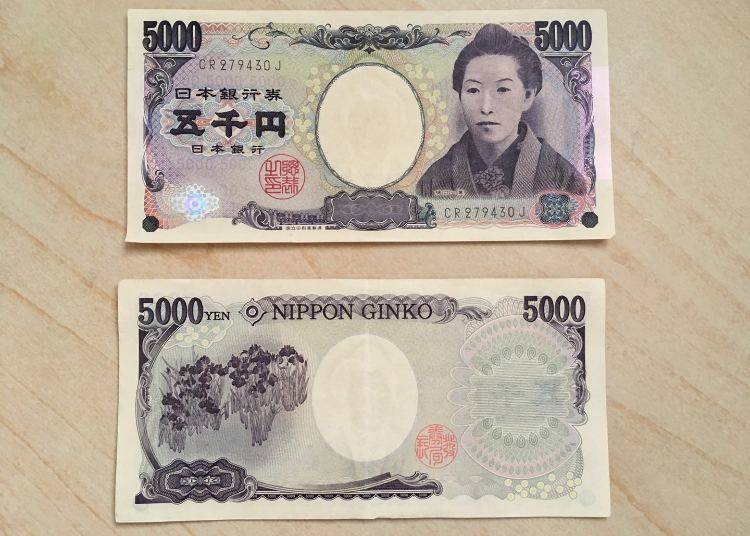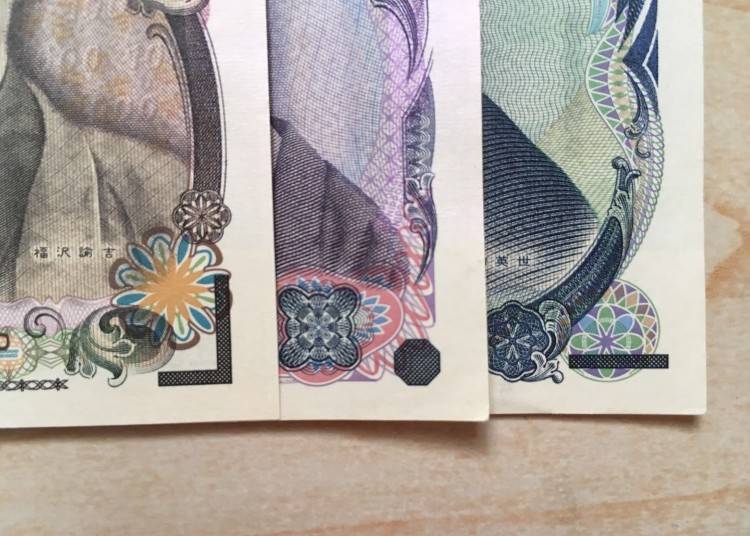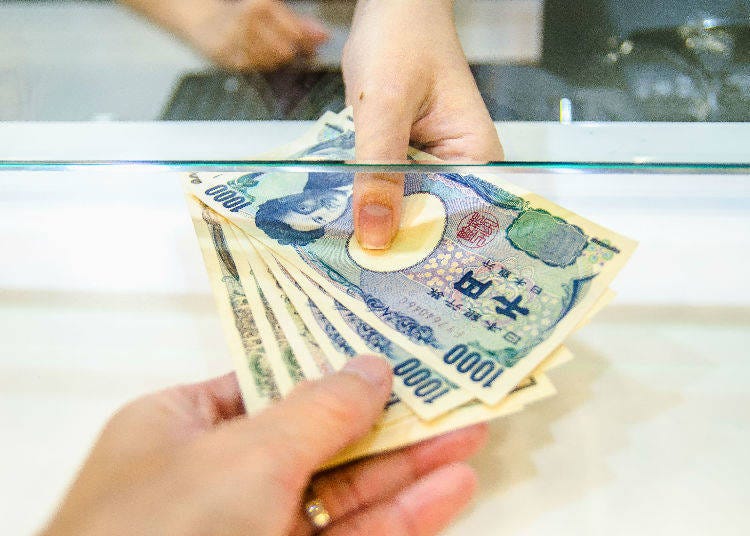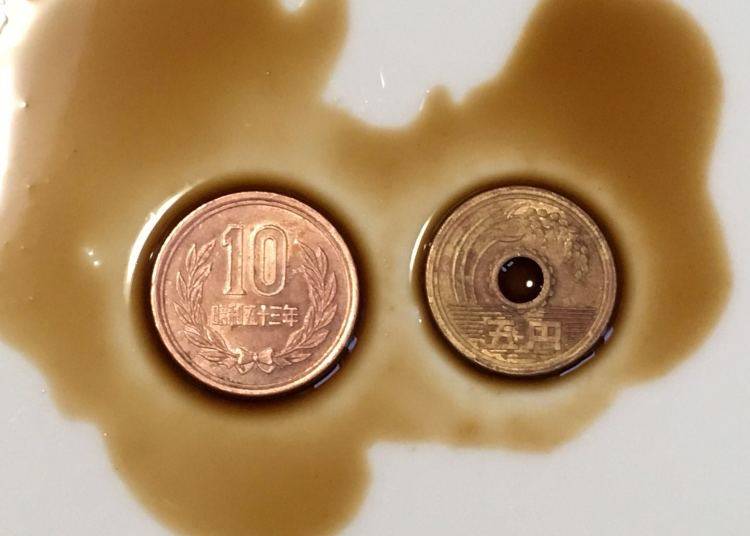
The materials used to make the bank notes and coins of a country and the designs for them differ from country to country. Normally the themes for the designs used often are the symbols of the country, such as plants and animals, scenery, and buildings. Historical figures are also often used. One of the pleasures of traveling abroad is looking at the currency of the countries being visited. Here are some interesting facts, some perhaps little known even to some Japanese, about the country’s currency.
Bank Notes of Japan
Japanese bills come in four denominations: 10,000 yen, 5,000 yen, 2,000 yen, and 1,000 yen notes.
10,000 yen Bill

Design (front): Yukichi Fukuzawa (A Meiji era thinker and educator and the founder of Keio University in Tokyo, one of Japan’s most prestigious private universities.)
Design (back): Phoenix bird statue of the Byodo-in Phoenix Hall Buddhist temple, a world heritage site (Kyoto)
Date issued: 2004
5,000 yen Bill

Design (front): Ichiyo Higuchi (A Meiji-era novelist and poet, the images of 17 individuals have appeared on the front side of bank notes and of these Ichiyo Higuchi is the only woman to be so honored.)
Design (back): The Kakitsubata-zu, a panel screen in the Nezu Museum by the Edo Period artist Ogata Korin, is on the reverse side.
Date issued: 2004
2,000 yen Bill

Design (front): Shuri Castle, the palace of the former Ryukyu Kingdom (Okinawa)
Design (back): A picture from the Tale of Genji and the author Murasaki Shikibu
Date issued: 2000
1,000 yen Bill

Design (front): Hideyo Noguchi (A bacteriologist who worked on yellow fever disease research)
Design (back): Mt. Fuji and cherry tree
Date issued: 2004
Currency Trivia #1: The Life of a Bill is 1 - 2 years. After that it is Processed as Toilet Paper!?

According to the Bank of Japan, the average life span of a 10,000 yen bill is about 4 - 5 years. 5,000 yen and 1,000 yen bills are used more often resulting in faster wear and tear which lowers their life spans to 1 - 2 years.
Bills in circulation are sent back to the Bank of Japan by financial institutions where they are checked for authenticity and damage before a decision is made to put them back into circulation or shred them. Bills that are shredded are recycled for use as housing materials, solid fuel, toilet paper, and office supplies or incinerated as general waste.
Currency Trivia #2: Bank Notes are Made to Enable the Visually Impaired to Distinguish Them!

The bank notes are made so that the visually impaired are able to distinguish them. By using ink applied more thickly in certain locations on the bills, they can be distinguished through touch.
The location of those more thickly printed areas are on the lower left and right corners of the front side. The 10,000 yen denomination is distinguished by “hook shape”, the 5,000 yen bill by an “octagonal shape”, the 1,000 yen bill by a “horizontal line”, and the 2,000 yen bill by the Japanese Braille symbol for “2”.


On the 10,000 yen and 5,000 yen bills there are holograms in the lower left corners on the front side which have a smooth feel to the touch and which also help distinguish the bills’ denominations. For the 5,000 yen bills issued after May 2014 the oblong transparent layer of the hologram was changed from an oblong to a square shape and increased 1.7 times in size. This was to further distinguish it from the 10,000 yen bill that has an oblong shaped hologram.
Neither the 1,000 yen nor 2,000 yen bill has a hologram. As the 2,000 yen bill is seldom seen in circulation, if the bill does not have a hologram, then it usually is a 1,000 yen bill.
Currency Trivia #3: Is It Possible to Exchange Damaged Bills? What Bills Can be Exchanged?

Damaged or soiled bills can be exchanged if taken to the Bank of Japan located in Nihonbashi, Tokyo or to one of its 32 branches within the country. (Exchanges can also be made at commercial financial institutions.) The following standard is used for determining the degree of damage when a bill is exchanged.

● If two-thirds or more of the bill remains it can be exchanged for its full value
● If more than two-fifths and less than two-thirds of the bill remains it can be exchanged for half its value
● If less than two-fifths of the bill remains then it cannot be exchanged
Currency Trivia #4: The Elusive 2,000 yen Bill

The 2,000 yen bill was issued to coincide with the Okinawa Summit that was held there in 2000. However, almost none of the bills are in circulation primarily for the reason that they cannot be used in most vending machines. In the year 2000, over 700 million of the bills were printed and in 2003 another 100,001,000, after which production was stopped. The 2,000 yen bill was not printed as a commemorative bill, however these days it is rarely seen and when it is, usually it is in Okinawa. As Japanese currency also makes its way to currency exchanges overseas, you might have a better chance of acquiring one if you exchange your money for Japanese yen before you come to Japan!
Where have all the 2,000 yen bills gone? Most of these bills are stored in the vaults of the Bank of Japan as they are less commonly used.
Currency Trivia #5: There are two types of 10,000 yen notes!

There are actually two design types used on the 10,000 yen bill. The one having a picture of the Phoenix on the reverse side that was issued in 2004 is most commonly seen; the other design is one of two pheasants. The 10,000 yen bill with the pheasants was issued in 1984, so it also does not have a hologram. These older bills are not usually seen in circulation, however if you should obtain one it still can be used.
Japanese Coins

Japanese coins have the following denominations: 500 yen, 100 yen, 50 yen, 10 yen, 5 yen, and 1 yen.

Coin Trivia #1: It Costs More Than 1 yen to Produce the 1 yen Coin!

The production cost of coins is not publically reported as the cost of the metals used fluctuates. If the current market cost of aluminum is used to calculate the value of a 1 yen coin, then it would cost two to three yen to make one 1 yen coin.
Using the same method of calculation, the costs for making individual coins for the other denominations would be seven yen for the 5 yen coin, ten yen for the 10 yen coin, about twenty yen for the 50 yen coin, about twenty-five yen for the 100 yen coin, and about thirty yen for the 500 yen coin.
Coin Trivia #2. Coins can be Cleaned by Putting Them in a Certain Solution

Coins darken after much use. If you put a 5 yen or 10 yen coin in a solution of vinegar or acidic liquid, it cleans them right up because both coins are made of copper and the acidity of the solution removes the grime. As an experiment, I found that acidic liquid much more effective. However, this will not work on the other coins because they are made from different metals.


Coin Trivia #3. Can Only Up to Twenty Coins be Used at One Time?

By law there is no restriction on the number of bank notes that can be used at one time. On the other hand, there are restrictions for coins. The number of coins that can be used at one time is limited to 20 times the face value of the coin. In other words, you can use twenty coins of the same denomination at one time. By law stores have the right to refuse acceptance of 21 or more coins of the same denomination.
This law was enacted out of consideration for inconveniences caused to recipients of coin payments, however, stores are free to accept 21 or more coins of the same denomination if they wish.
Coin Trivia #4. Why are There Holes in the 5 yen and 50 yen Coins?

Both the 5 yen and 50 yen coins have holes in their centers, but the reason for that is different for each. In the case of the 5 yen coin it is done to save money on the cost of the metal. The 5 yen coin was first issued in 1949 and at that time so shortly after the war, the cost of raw materials used in rebuilding the infrastructure rose quickly, so as a cost-cutting measure, the hole was put in the 5 yen coin.
As for the 50 yen coin, it was added to further distinguish it from the 100 yen coin because they both are the same color.
Coin Trivia #5. Bank Notes and Coins are not Made in the Same Place

Bank notes are issued by the Bank of Japan and printed at the National Printing Bureau located in Toranomon, Tokyo. These bills are officially called bank notes, and they are printed by the Bank of Japan and not the government.
Coins, on the other hand, are issued by the Japanese government and manufactured at mints. The main mint is located in Osaka and there is also one in Tokyo and another in Hiroshima. The Osaka Mint is famous for its cherry trees and when they are in full bloom in spring many people come to see them.
Summary

When traveling we use money without giving much thought to it, however, understanding more about it in detail provides further insight and understanding of that country’s culture and historical background. We hope that when you visit Japan you’ll take a moment to notice and enjoy the information about the currency we have provided.
- Area
- Category
*Prices and options mentioned are subject to change.
*Unless stated otherwise, all prices include tax.
Popular Tours & Activitiess
Recommended places for you
-

Japan’s Shinkansen Is About to Change Travel in an Unexpected Way
by: Guest Contributor
-

New in Ginza! Air BicCamera Ginza Opens with a Faster, More Convenient Shopping Experience
by: Guest Contributor
-

Only in Tokyo? A Legendary Manga Artist's New Masterpiece Is Hiding Underground
by: Guest Contributor
-

Make Your Japan Trip Unforgettable! Explore "OSHI MAP" – Now Free and Unlimited
by: Guest Contributor
-
Ad

Complete Guide to Ueno's National Museum of Nature and Science, the Perfect Place to Visit on Rainy Days or With Children
-

Jujutsu Kaisen Takes Over JR East With a Wrapped Shinkansen This Winter
by: Guest Contributor
Inspiration for Accommodations
-

Enjoy Mt. Fuji from the Comfort of Your Room! Recommended Ryokan with Mt. Fuji View
-

Stay Near the Cherry Blossoms! Hotels for Cherry Blossom Viewing in Tokyo
-

Family-Friendly Hotels with Free Shuttle to Disneyland: Convenient Access for a Magical Stay
-

Top Ranked Hakone Hotels with Mt. Fuji View: Enjoy Stunning Scenery from Your Private Space
-

Convenient Tokyo Hotels with Airport Shuttle: Ideal for Families and Heavy Luggage
-

Stunning Tokyo Tower View Hotels: Enjoy Spectacular Scenery from Your Private Space
-

Convenient Asakusa Hotels with Kitchens: Ideal for Extended Family Visits
-

Experience Luxury: Hakone's 10 Best Five-Star Accommodations
-

Enjoy Mt. Fuji Autumn Leaves! Top Hotels Near the Popular Autumn Leaves Corridor
-

Experience Hakone Fall Foliage from Your Room with Stunning Views
-

Shibuya Crossing: Getting the Best View from the Deck at Magnet by Shibuya109!
-

Public Transportation Etiquette
-

Tokyo Tsukiji|Tsukiji Area Map & Sightseeing Information
-

Ikebukuro Station Area Guide: Top 15 Spots When You Escape the Station's Maze!
-

Authentic Food, Events & More at Tokyo's 2022 Philippine Festival (Dec 3-4)
-

[MOVIE] Survival Japanese: Shopping
- #best ramen tokyo
- #what to buy in ameyoko
- #what to bring to japan
- #new years in tokyo
- #best izakaya shinjuku
- #things to do tokyo
- #japanese nail trends
- #what to do in odaiba
- #onsen tattoo friendly tokyo
- #daiso
- #best sushi ginza
- #japanese convenience store snacks
- #best yakiniku shibuya
- #japanese fashion culture
- #best japanese soft drinks



















